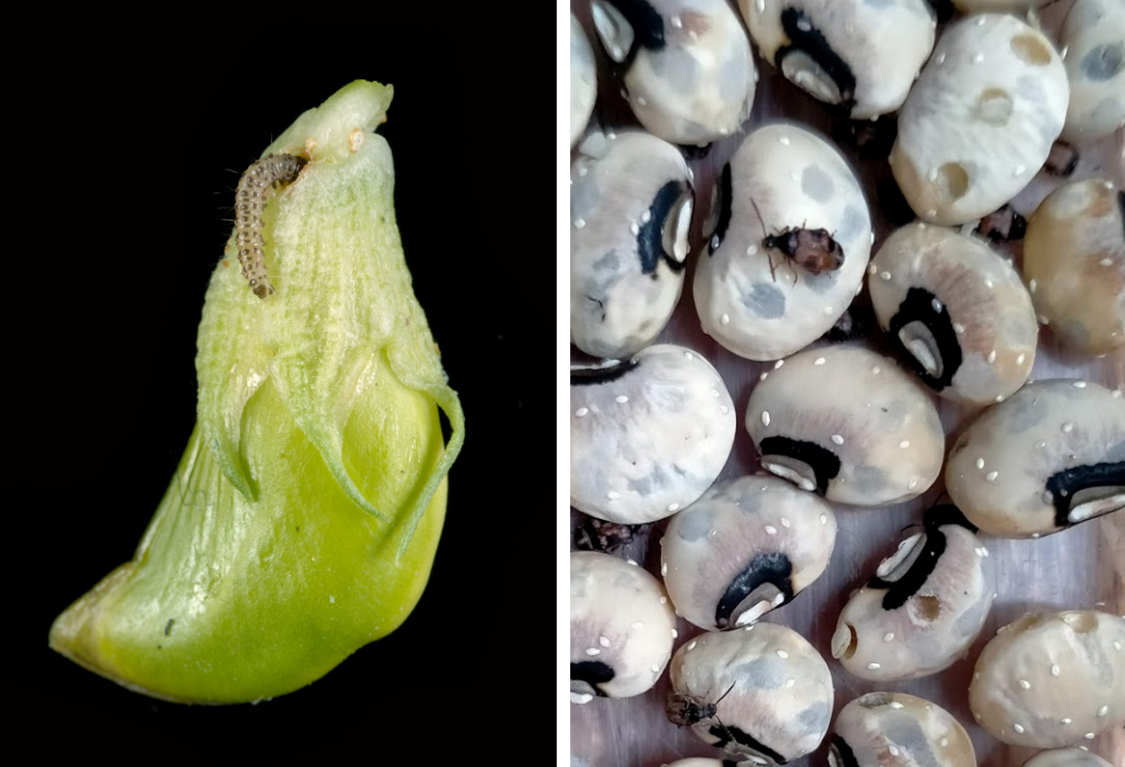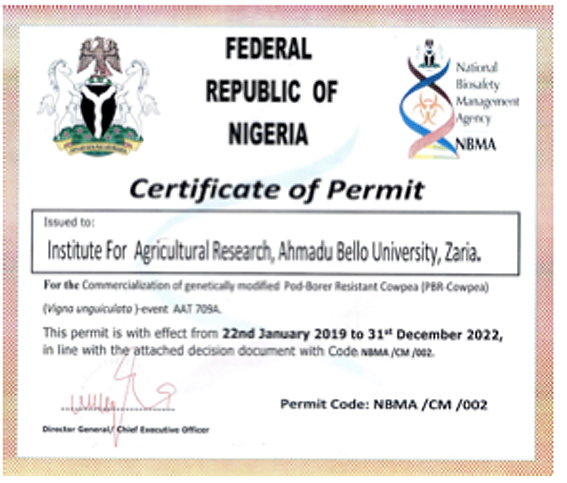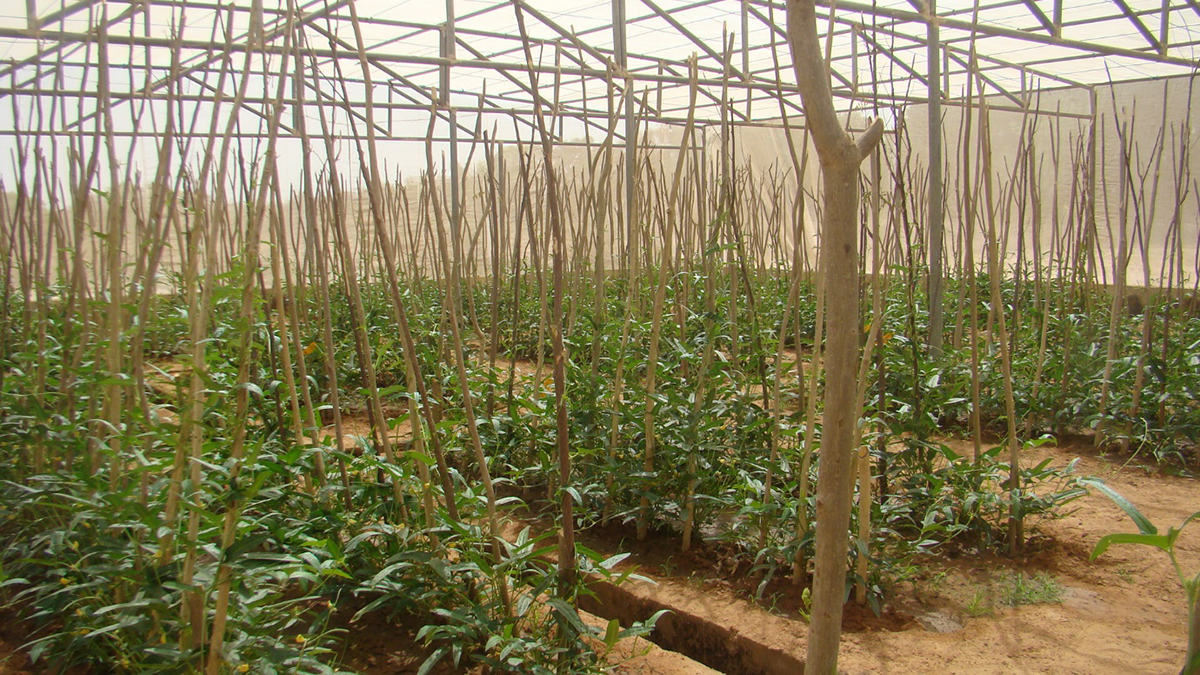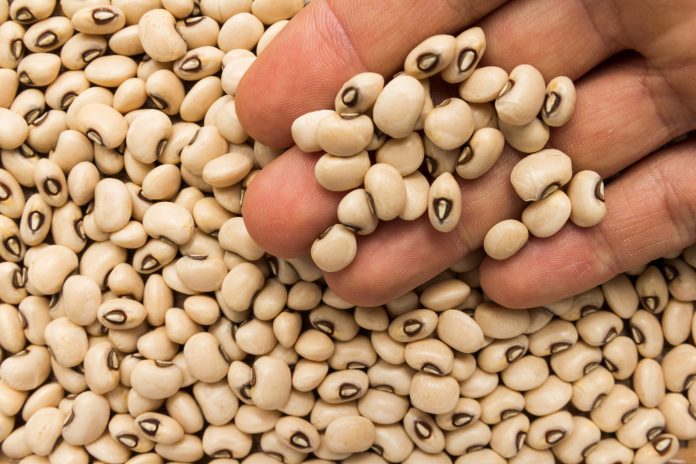Jose M. Barrero, Donald J. MacKenzie, Richard E. Goodman and T.J.V. Higgins provide an in-depth look at what we need to know about a biotech shield for cowpea against the major insect pests
Cowpea (Vigna unguiculata) is a vital staple crop in West Africa consumed daily by more than 200 million people and provides an important source of income. Nigeria, the largest producer, still needs to import around 500,000 tonnes per year to meet domestic demand. This is because insects can reduce yields by 90%, both pre- and post-harvest (Singh, 1990). One of the major pre-harvest pests is the lepidopteran (moth), Maruca vitrata, known as the pod-borer.
The major post-harvest or storage pest is the coleopteran (beetle), Callosobruchus maculatus, known as the cowpea weevil, which is a bruchid (Figure 1). Pre-harvest cowpea yield losses due to the pod-borer range from 20 to 80% (Ba et al., 2019) and it is conservatively estimated that over 30,000 tonnes are lost to bruchids annually during storage (Caswell, 1981). More recently, the post-harvest bruchid damage has been estimated at 25% (Baributsa et al., 2010). Genetic solutions for both problems are feasible using biotechnology, and their deployment in the field to control these pests would allow Nigeria and neighbouring countries to become self-sufficient with less reliance on chemical pesticides.
A solution against the pod-borer is underway
In December 2019, a historical milestone was achieved in Nigeria when the world’s first genetically modified (GM) cowpea variety was registered for commercial use. The new variety, named SAMPEA 20-T, carries a plant version of the bacterial gene, cry1Ab from Bacillus thuringiensis (Bt). It was developed by an international team, coordinated by the African Agriculture Technology Foundation (AATF; Kenya) in collaboration with the Institute for Agricultural Research (IAR; Nigeria), Ahmadu Bello University (Nigeria), the Commonwealth Industrial and Research Organisation (CSIRO; Australia) and the Institute for International Crop Improvement at the Donald Danforth Plant Science Center (DDPSC; U.S.). The commercial release of SAMPEA 20-T was a response to local demand for this product because of the potential benefits that it could bring to farmers.
A pod-borer resistant (PBR) cowpea using traditional breeding is not possible due to the lack of naturally resistant compatible germplasm, so farmers were using chemical insecticides to control the pest. But insecticides are relatively expensive for smallholder farmers and can be dangerous because many farmers may not understand the product formulation and instructions, and because of the lack of protective clothing for insecticide application. Because of this, the support of the Rockefeller Foundation, the U.S. Agency for International Development (USAID) and CSIRO led to the development of a Bt cowpea that provides built-in full protection against Maruca which allows a cheap, safe and scalable solution to the problem (Addae et al., 2020). If PBR cowpea was adopted at 100% in Nigeria, Niger and Benin under efficient seed distribution systems and without trade barriers, it has been estimated that the social welfare gain would be at least U.S. $848 million per year across the three countries (Gbègbèlègbe et al., 2015). In Nigeria alone, and using more conservative estimates on rates of adoption (between 15–45%), Phillip et al. (2019) estimated that producers and consumers could gain U.S. $350 million over 25 years
The successful release of any GM crop relies on a careful and detailed assessment of the unique transgenic event (plant line) that must have a series of characteristics that guarantee its safe use and its improved performance in the field.

For SAMPEA 20-T, the transgenic cowpea event 709A which was created in 2007, was chosen. Several studies were undertaken to demonstrate that cowpea varieties containing this event were unlikely to pose any risk to the environment, and that food and livestock feed derived from it are as safe as food and feed derived from conventional cowpea varieties. The risk/safety assessment of a GM crop considers four broad areas of information, including the molecular-genetic characterisation of the transgenic event, the safety of any newly expressed proteins, the presence of intended or unintended changes to the nutrient composition, and likely environmental effects such as the potential consequences of outcrossing, altered weediness or impacts on non-target organisms.
Event 709A was produced by Agrobacterium tumefaciens-mediated transformation of cotyledonary nodes with the introduction of the cry1Ab gene from B. thuringiensis and the neomycin phosphotransferase II (nptII) gene from Escherichia coli as a selectable marker. Molecular characterisation of the introduced DNA in the 709A cowpea confirmed the presence at a single insertion site that was stably inherited over multiple generations as a single genetic locus. Nucleotide sequencing of the entire inserted DNA, including portions of the 5’ and 3’ flanking cowpea genomic sequence, confirmed its expected structure and sequence. The insertion of the T-DNA was mapped to chromosome 2 of the cowpea genome. It did not create any novel open reading frames with the potential to encode proteins with any significant amino acid sequence similarity to known or suspected toxins or allergens.
The only newly expressed proteins in 709A cowpea are Cry1Ab and NPTII, both of which have been subjected to extensive safety assessment in more than 90 and 120 single or combined plant events, respectively. Bioinformatic analyses of the amino acid sequences of both Cry1Ab and NPTII found no significant sequence similarities with proteins having toxicity to mammals or significant similarities to allergens. The published acute oral toxicity studies using event 709A found no adverse effects at exposure levels of 4,000 and 5,000 mg/kg of the proteins based on body weights at the highest dosages tested, which were >1,000 times actual levels based on measured protein concentrations in various cowpea plant tissues. The highest concentrations of Cry1Ab were measured in flower tissue (5.6–22.8 µg/g FW) and pods (5.7–17.9 µg/g), while average Cry1Ab concentrations in leaves, green cotyledons and dry seed ranged between 2.6–4.1 µg/g. The highest amounts of NPTII protein were in dry seed samples, with an average concentration of 1.5 µg/g. The U.S. Environmental Protection Agency has issued exemptions from the requirement of a tolerance for both the Cry1Ab and NPTII proteins expressed in event 709A cowpea, meaning that these proteins are considered safe at any conceivable level of dietary exposure.
Compositional analyses were performed to compare the concentrations of major nutrient components in samples of whole grain, leaves, and fodder collected from event 709A and control cowpea grown at multiple locations representing the typical cowpea growing conditions in West Africa. There were no significant differences in composition, and it was concluded that food products derived from 709A cowpea are compositionally equivalent to non-GM plants.
The genetic modification resulting in cowpea event 709A was not intended to affect a specific agronomic or phenotypic characteristic, except to confer resistance to lepidopteran pests such as the cowpea pod borer. To confirm that 709A cowpea was otherwise agronomically equivalent to its conventional counterpart, yield and other agronomic measurements were made at multi-locations in confined field trials. Overall assessment of the agronomic data from multiple years of testing did not identify trends of significant differences between 709A and control cowpea except for resistance to Maruca damage.

National Biosafety Management Agency of Nigeria in 2019
These results supported the conclusion that the genetic modification resulting in event 709A did not have an unintended or unexpected effect on plant growth general morphology, vegetative vigour, or grain yield. From the observations, there were no indications that 709A cowpea would be more invasive or persistent in the environment or have altered susceptibility to pests and diseases, compared to conventional cowpea. There are no unique arthropod (insect) species in the likely deployment area for Bt cowpea in Africa that have not been assessed elsewhere for other GM crops (Ba et al., 2018), so the existing data on the environmental safety of Cry1Ab to non-target organisms were sufficient to complete the environmental risk assessment of 709A cowpea.
After considering all the data and information submitted, including comments during the public consultation, the National Biosafety Management Agency of Nigeria issued a permit (Figure 2) on January 22, 2019, for the commercialisation of 709A cowpea, which is valid through December 31, 2022.

Photo courtesy of Dr J Batieno. Samples are analyzed to demonstrate gene stability, plant and
seed quality and control of insect pests.
New improved versions of Bt crops carrying more than one protective gene are recommended to avoid the likely development of resistance in the insect populations. We are now working on the development of the second generation PBR cowpea carrying both the cry1Ab and cry2Ab genes to provide durable insect resistance. These genes were provided by Bayer Crop Science on a humanitarian basis, so that smallholder farmers can access the new GM varieties, royalty-free. The development of the new double Bt cowpea is well advanced with Cry2Ab elite events selected and several years of confined field trials successfully completed in Nigeria, Ghana and Burkina Faso (Figure 3). Following regulatory approval of the Cry2Ab single event, it is hoped that breeding it into varieties already containing event 709A will not require additional regulation and that new varieties producing both Cry1Ab and Cry2Ab can be adopted by farmers within the next five years.
A promising weapon for bruchid control
While the PBR cowpea has been approved for deployment in Nigeria, there is still no answer to the bruchid (storage beetle) problem. There is no effective host plant genetic resistance to the cowpea bruchids, and although there are some traditional practices to control them such as mixing the seed with ashes, those methods are inefficient. Today, the two more common methods to control this major pest are the use of chemical insecticides and the Purdue Improved Cowpea Storage Technology hermetic bags (PICS bags; Baributsa et al., 2010, Murdock et al., 2012). Insecticides are a serious health risk during application, and when used to treat storage pests can be the main cause of pesticide residues in cowpea grains (Olufade et al., 2014; Olutona and Aderemi, 2019). Bruchid infestation often starts in the field when the grain moisture content is high, and it continues in storage. The larvae burrow into the seeds to feed and develop in the seeds. When the adult female emerges, after four weeks, she can lay up to 100 eggs rapidly spreading the infestation.
It is common for 60 to 100% of the harvest to be damaged within a few months of storage. Damage to seeds can happen at different stages, including at the farm level, with the trader, the retailer, the processor, or the consumer. Stored grain damage is a major cause of economic losses in tropical subsistence agriculture (Rees, 2004). The PICS bags are particularly suited for use after the grain has been harvested and passed to large scale traders and beyond. The economic impact of this seed predation is very large because it will impact the selling price at each level and can produce low germination rates of affected seeds. The risk forces farmers to sell the grain immediately after harvest at a low price to avoid storage losses. In addition, it predisposes cowpea-based foods to contamination with mycotoxins after a primary infestation and this compromises the nutritional composition of the seeds (Rees, 2004; Afolabi et al., 2020).
Seed-incorporated protection using gene technology to express the α-amylase inhibitor (αAI) gene from common bean (Phaseolus vulgaris) has been described for peas and chickpeas (Shade et al., 1994, Sarmah et al., 2004, Campbell et al., 2011) and could be a promising solution for cowpea in Africa. In preliminary studies, we and others have produced several legumes, including cowpeas, carrying the αAI gene from beans which were shown to be fully resistant to Callosobruchus spp (Lüthi et al., 2013, Higgins et al., 2012, Solleti et al., 2008, Ishimoto et al., 1996). The cowpea product is still at the proof-of-concept stage and needs to be produced at scale.
A full molecular characterisation, rigorous biosafety studies (Goodman & Ofori-Anti, 2012), and efficacy tests in the granary are needed. A biotech solution against cowpea bruchids could complement other methods of control, including PICS bags, providing a new technological option for farmers. This could bring large economic benefits to farmers, traders, processors as well as consumers with a health benefit because for the first time since the introduction of DDT in Sub-Saharan Africa, people could consume cowpea with low insecticide residues. In a study of the benefits of using PICS bags, it was conservatively estimated that the extra cash flow for African farmers and households attributed to PICS was nearly $34 million for the 2012-13 storage year (Moussa et al., 2014). The development and deployment of a GM bruchid-resistant cowpea could further increase the benefits to farmers, both economic and health-wise, without the need for the increased use of plastic storage bags.
Future prospects
Pod-borer resistant cowpea can now be added to the list of biotechnologically improved crops that contribute to the United Nations Sustainable Development Goals, which the international community has committed to addressing by 2030. SAMPEA 20-T provides full protection against pod-borers resulting in significantly increased harvestable yield, with the first certified seed available for planting by Nigerian farmers in 2021, followed soon by Ghana and Burkina Faso.
Responsible product stewardship that includes ensuring the availability of high-quality tested seed, education and outreach to smallholders, and monitoring of product performance will be essential to the long-term success of PBR cowpea and the future acceptance of other GM crops. The release of a locally developed GM crop in Africa, particularly in the face of opposing ideologies, is a very significant achievement that should accelerate the implementation of biotechnology to solve not only productivity constraints but also to reduce post-harvest losses, such as those caused by bruchids.
Acknowledgements
We wish to acknowledge the Rockefeller Foundation, USAID and CSIRO for financial support, Monsanto for in-kind support of this project and our colleagues at AATF, IICI DDPSC, IAR Nigeria, INERA Burkina Faso, SARI Ghana and CSIRO for their many contributions to insect-resistant cowpea.
References
Addae PC, Ishiyaku MF, Tignegre J-B, et al., 2020. Efficacy of a cry1Ab Gene for Control of Maruca vitrata (Lepidoptera: Crambidae) in Cowpea (Fabales: Fabaceae). Journal of Economic Entomology.
Afolabi CG, Ezekiel CN, Ogunbiyi AE, Oluwadairo OJ, Sulyok M, Krska R, 2020. Fungi and mycotoxins in cowpea (Vigna unguiculata L) on Nigerian markets. Food Additives & Contaminants: Part B 13, 52-8.
Ba MN, Huesing JE, Tamò M, Higgins TJV, Pittendrigh BR, Murdock LL, 2018. An assessment of the risk of Bt-cowpea to non-target organisms in West Africa. Journal of Pest Science.
Baributsa D, Lowenberg-Deboer J, Murdock LL, Moussa B, 2010. Profitable chemical-free cowpea storage technology for smallholder farmers in Africa: opportunities and challenges. In. 10th International Working Conference on Stored Product Protection. Julius-Kuhn-Archiv, 1046-52 (425).
Campbell PM, Reiner D, Moore AE, Lee R-Y, Epstein MM, Higgins TJV, 2011. Comparison of the α-Amylase Inhibitor-1 from Common Bean (Phaseolus vulgaris) Varieties and Transgenic Expression in Other Legumes—Post-Translational Modifications and Immunogenicity. Journal of Agricultural and Food Chemistry 59, 6047-54.
Caswell GH, 1981. Damage to stored cowpea in the northern part of Nigeria. Samaru Journal of Agricultural Research 1, 11-19.
Gbègbèlègbè SD, Lowenberg-Deboer J, Adeoti R, Lusk J, Coulibaly O, 2015. The estimated ex ante economic impact of Bt cowpea in Niger, Benin and Northern Nigeria. Agricultural Economics 46, 563-77.
Goodman R, Ofori-Anti A, 2012. Assessing the potential allergenicity of genetically modified (GM) cowpea following CODEX Alimentarius guidelines. In: Boukar O, Coulibaly O, Fatokun C, Lopez K, Tamo M, eds. Innovative research along the cowpea value chain. 2012. Proceedings of the Fifth World Cowpea Conference on Improving livelihoods in the cowpea value chain through advancement in science Saly, Senegal: IITA, 162-76.
Higgins TJV, Gollasch S, Molvig L, et al., 2012. Insect-protected cowpeas using gene technology. In: Boukar O, Coulibaly O, Fatokun C, Lopez K, Tamo M, eds. Fifth World Cowpea Conference on improving livelihoods in the cowpea value chain through advancement in science. Saly, Senegal: IITA, 131-7.
Ishimoto M, Sato T, Chrispeels MJ, Kitamura K, 1996. Bruchid resistance of transgenic azuki bean expressing seed α-amylase inhibitor of common bean. Entomologia Experimentalis et Applicata 79, 309-15.
Lüthi C, Álvarez-Alfageme F, Ehlers JD, Higgins TJV, Romeis J, 2013. Resistance of αAI-1 transgenic chickpea (Cicer arietinum) and cowpea (Vigna unguiculata) dry grains to bruchid beetles (Coleoptera: Chrysomelidae). Bulletin of Entomological Research 103, 373-81.
Moussa B, Abdoulaye T, Coulibaly O, Baributsa D, Lowenberg-Deboer J, 2014. Adoption of on-farm hermetic storage for cowpea in West and Central Africa in 2012. Journal of Stored Products Research 58, 77-86.
Murdock LL, Margam V, Baoua I, Balfe S, Shade RE, 2012. Death by desiccation: Effects of hermetic storage on cowpea bruchids. Journal of Stored Products Research 49, 166-70.
Olufade YA, Sosan, MB, Oyekunle JAO, 2014. Levels of Organochlorine Insecticide Residues in Cowpea Grains and Dried Yam chips from markets in Ile-Ife, Southwestern Nigeria: A Preliminary Survey. Ife Journal of Science 16, 161-170.
Olutona, GO, Aderemi, MA, 2019. Organochlorine pesticide residue and heavy metals in leguminous food crops from selected markets in Ibadan, Nigeria. Legume Science. 1:e3.
Phillip D, Nin-Pratt A, Zambrano P, Wood-Sichra U, Kato E, Komen J, Hanson H, Falck-Zepeda JB, Chambers J, 2019. Insect-resistant cowpea in Nigeria: An ex ante economic assessment of a crop improvement initiative: IFPRI Discussion Paper 01896.
Rees D, 2004. Insects of Stored Products. 1st Edn., CSIRO Publishing, Collinwood, Australia, pp: 192.
Sarmah BK, Moore A, Tate W, et al., 2004. Transgenic chickpea seeds expressing high levels of a bean a-amylase inhibitor. Molecular Breeding 14, 73-82.
Shade RE, Schroeder HE, Pueyo JJ, et al., 1994. Transgenic pea seeds expressing the a-amylase inhibitor of the common bean are resistant to bruchid beetles. Bio/Technology 12, 793-6.
Singh SR, 1990. Insect pests of cowpea. In: Insect Pests of Tropical Food Legumes, ed. S. R. Singh, xvi + 451 pp. Chichester: John Wiley & Sons.
Solleti S, Bakshi S, Purkayastha J, Panda S, Sahoo L, 2008. Transgenic cowpea (Vigna unguiculata) seeds expressing a bean α-amylase inhibitor 1 confer resistance to storage pests, bruchid beetles. Plant Cell Reports 27, 1841-50.
Zafar MM, Razzaq A, Farooq, MA, et al., 2020. Insect resistance management in Bacillus thuringiensis cotton by MGPS (multiple genes pyramiding and silencing). Journal of Cotton Research 3, 33.
*Please note: This is a commercial profile
© 2019. This work is licensed under CC-BY-NC-ND.











